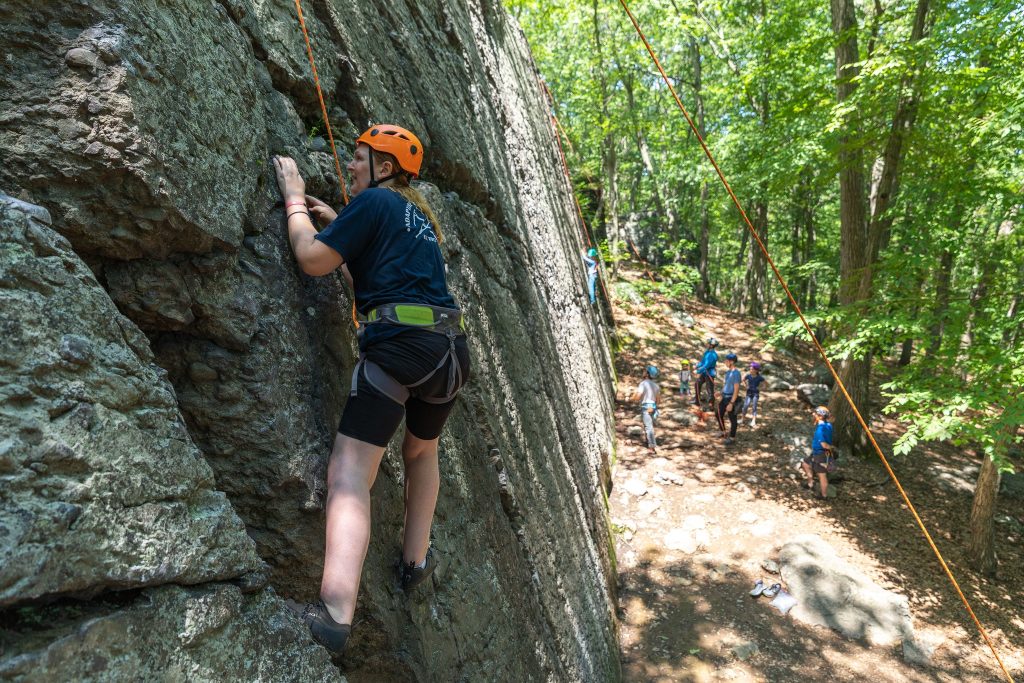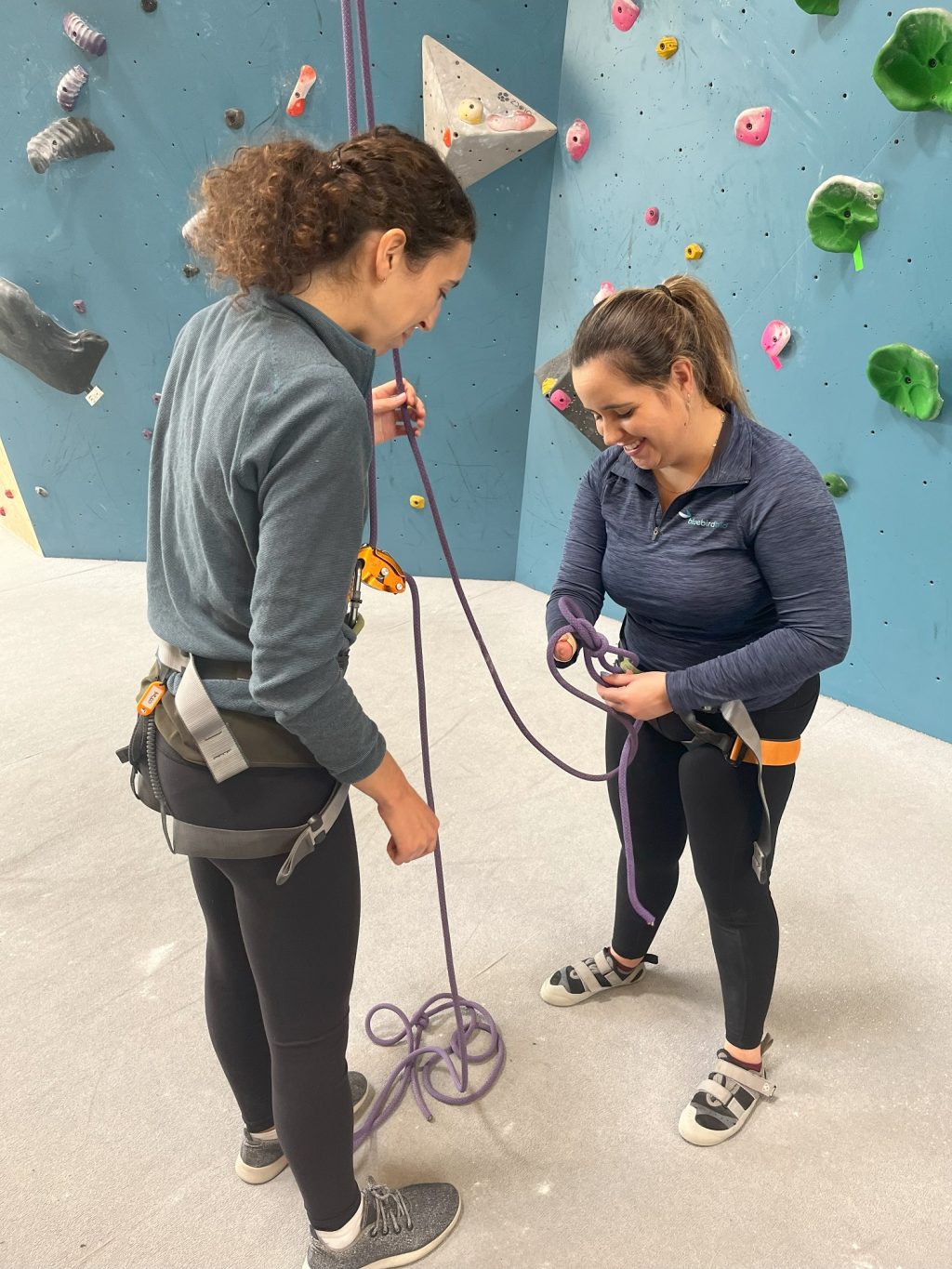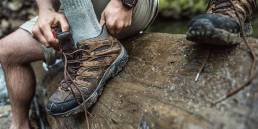An average person may look up at a rock wall and imagine scaling it, with fingertips and toes tracing the crevices available for leverage. Yet those with physical or psychological challenges might not see the wall from the same perspective. They may never even imagine it’s possible for them to find a route to the top.
Bridging the gap between these two perspectives is the Adaptive Climbing Group (ACG), a volunteer-run organization that has been dedicated to boosting climbers of all abilities for nearly 10 years. In the Boston area, there are about 98 people involved, ascending pitches at rock gyms and on outdoor cliffs and crags in the region.
ACG is growing rapidly, with new chapters forming in cities like Memphis, Tennessee; Athens, Georgia; and Washington, D.C. In the Northeast, Massachusetts’s ACG organization is partnering with the Eastern Mountain Sports Climbing School to overcome the obstacles to getting more people on pitches.

Boosting Individuals and Building Community
Some who have tried rock climbing with the ACG are seeing life from a new perspective.
“It took me a few tries before I got to the top for the first time,” says Cambridge resident Sarah Kellar, 35. When she checked out ACG at Boston Bouldering Project in Somerville back in 2019, she was noncommittal, thinking she’d give it a try and then move on to something else. To her surprise, the combination of mental and physical exertion—as well as the camaraderie of the group—got her hooked. Now she’s working on routes that are 5.7 to 5.9 and hopes to improve her bouldering skills too.
“Everyone in the group, including the other climbers, is just so nice and supportive of each other. That’s what I love, they encourage everyone to do their best and not give up. It’s a very positive group.”
Kellar’s first outdoor climb was on a hunk of puddingstone that rises above the shore of Hammond Pond in Newton behind Chestnut Hill Mall. She was there in August with an ACG group and EMS Climbing School instructors.
“I enjoy watching other people climb to get pointers and see if there’s anything I could be doing differently,” Kellar says, adding that she also confers with her belayer for tips before tackling a slab.
Instructors Take Lessons from Clients
The EMS Climbing School has been involved with ACG’s outdoor climbs for three years, says manager Keith Moon. “All of our instructors have professional guide training through the American Mountain Guides Association. At this time, there is no nationally recognized adaptive training available. We want everyone who is interested in climbing to get a chance to experience it, and we have worked as a team to develop ideas and techniques to accommodate the different needs that some participants have. A simple example of this is setting up two climbing systems right next to each other so that a participant can have one of the guides or a volunteer next to them the whole time for coaching and support.”
Along with the popular Hammond Pond site in Newton and Rumney, New Hampshire, the Massachusetts and New York branches of ACG offer members a combined trip to Acadia in Maine each summer.
The process of choosing outdoor venues for EMS guides and ACG participants requires more than the usual visual or online perusal. For ACG, a site must be easy to get to, offer a variety of vertical challenges, and have enough room at the base for everyone to hang out and socialize.

It Started at EMS
Partnering with the EMS Climbing School brings ACG full circle. The group’s founder, Kareemah Batts, worked at an EMS store in Manhattan in 2013 when she found the time and energy to start climbing. Soon she invited people from her amputee support group to join, and then corralled EMS coworkers to donate their time to help the growing group at Brooklyn Boulders indoor gym. In the nearly 10 years since, Batts has been a competitive climber, coach, and founder of the growing organization. She was the first paraclimber to compete in the USA Climbing Competition, and Adidas featured her in its Terrex “United by Summits” campaign.
“You have to educate and explain to people without the lived experience why some things are important and why something will or won’t work,” Batts says. “Everybody’s mobility and fear and experience is unique.”
Along the way, she’s worked with all involved to keep the bar to entry low—including getting pricing deals from manufacturers and soliciting funding from foundations.
The American Alpine Club recently chose ACG as an affiliate, a two-year program that will help ACG grow, get established as a nonprofit, and develop its resources.
Volunteers Help ACG Evolve
Currently, Batts relies on volunteers in each region to execute local events like indoor opportunities as well as outdoor rock and ice climbing. With competent people in place, she no longer has to travel out of state frequently to oversee events and she aspires to make the organization sustainable for future generations to enjoy.
“It’s the dedication of the people that makes it work,” Batts says of ACG’s regional volunteer leadership. “I just tap into the passion of others.”
Among the local volunteers is Lou Lim, Communications Lead for the Boston-area ACG. “I love the humility and growth of what ACG does,” he says, noting that there’s an ACG program for youth too, as well as training sessions for participants to learn belaying.
“ACG is consistently growing and evolving,” says Lim. “We take the pulse of what’s happening in the chapter, listening to what the participants want.”
Charlotte Rutherford, the Massachusetts organization’s Climber Development Lead, says the group’s motto is, Climb as you are.
“That’s why I continue to come back,” says Rutherford. “I meet like-minded people who don’t care what you can or can’t do or what’s making you different. I’m just here to celebrate people who come to climb.”
For Henry Ko, ACG’s Administrative Lead, being part of a person’s evolution from non-climber to avid climber is invigorating. “I’ve talked to a lot of gym climbers who think they can’t move to outdoor climbing,” he says. “Our relationships with them help to ease that worry.”
ACG spawns enthusiasm for climbing, reigniting the passion that even longtime climbers and guides feel for the sport. “I’ve found working with the ACG climbers and volunteers to be personally and professionally rewarding,” says EMS climbing guide Doug Martland. “Climbing is such an awesome sport, and it’s great to share ropes with folks whose mission it is to give everybody a chance to climb, particularly on some of my favorite outdoor routes in Greater Boston and New Hampshire. I’m looking forward to the next outing.”
For Batts, getting people climbing is a first step. After that, the sky’s the limit. “The platform [ACG] created access for people, now some are brand ambassadors. I want to turn them into ACG guides and go to Yosemite.”

Supporting Those Who Support the ACG
Volunteers are key to the ACG’s ongoing success. To join their Boston area organization as either a climber or volunteer, check out their website. If you don’t have time to volunteer but want to contribute to the cause, consider visiting the organization’s donate page on their website.
Alison O'Leary
Alison O’Leary is an avid cross country skier, author, and public speaker. See alisonoleary.com.
Related Posts
April 24, 2024
What to Bring When Road Tripping with Your Dog
Prepare for the ultimate road trip with…




